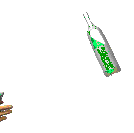Absinthe Explained

Absinthe: Mind-Altering Effects Explained
LiveScience | Charles Q. Choi
In recent years, the psychedelic nature of absinthe has been hotly debated. Absinthe was notorious among 19th-century and early 20th-century bohemian artists as "the Green Fairy" that expanded the mind. After it became infamous for madness and toxic side effects among drinkers, it was widely banned.The modern scientific consensus is that absinthe's reputation could simply be traced back to alcoholism, or perhaps toxic compounds that leaked in during faulty distillation. Still, others have pointed at a chemical named thujone in wormwood, one of the herbs used to prepare absinthe and the one that gives the drink its green color. Thujone was blamed for "absinthe madness" and "absinthism," a collection of symptoms including hallucinations, facial tics, numbness and dementia.
"Today it seems a substantial minority of consumers want these myths to be true, even if there is no empirical evidence that they are," said researcher Dirk Lachenmeier, a chemist with the Chemical and Veterinary Investigation Laboratory of Karlsruhe in Germany.
Watch this video on how absinthe is prepared:










